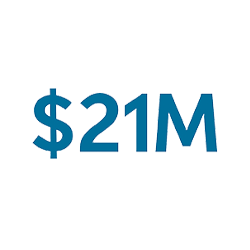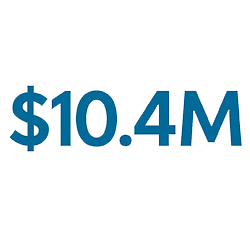PFAS Settlements: Billions in Funding Still Available
Additionally, utilities incurring PFAS-related costs before July 2026 may also qualify for further reimbursement through upcoming Special Needs Fund claims — with deadlines fast approaching.
↓ Continue Reading Below ↓

In the summer of 2025, municipalities and water systems across the country began receiving their first payments from the PFAS (per- and polyfluoroalkyl substances) drinking water settlements with 3M and DuPont, which offer a combined total of up to more than $14 billion to public water providers that have detected PFAS in their drinking water sources. This not only marks a major step towards financial relief for local governments and utilities facing costs for PFAS contamination, but, since the use of settlement funds is not restricted, may also help close other funding gaps.
Now that disbursements to the first phase of beneficiaries have begun, it's clear that many water providers will be recovering significant funds from these settlements. Some individual cities expect their payments to be in the tens of millions of dollars—real money that they no longer have to draw from limited municipal resources or rate hikes. However, recoveries of this scale do not happen by accident. Although all eligible public water systems were automatically included in these settlements unless they formally opted out by the 2023 deadlines, claims must be submitted correctly by the due dates in 2026 to receive funds. Claims can require additional water quality testing of every source, the collection of extensive documentation, and even strategic planning in order to maximize settlement payouts. Water agencies and municipalities can also seek to supplement their total recoveries by submitting additional claims to reimburse PFAS testing costs and other expenses already incurred for PFAS treatment or management.
But be aware: Water providers that did not opt out of the settlements but miss testing and filing deadlines will be ineligible to recover any funds at all through the settlements, and they will have forfeited their right to file future lawsuits against 3M and DuPont over PFAS drinking water contamination. Therefore, it is crucial to stay ahead of settlement requirements to avoid missing out on potential funding.

Significant Funding at Stake: Some Cities Receiving 8- and 9-Figure PFAS Settlement Payments
For some, the term “class action settlement” may conjure images of $10 checks in the mail, leading them to believe that submitting claims in the PFAS drinking water settlements isn’t worth their time. On the contrary, the magnitude of these settlements means that, with proper strategy and preparation, individual utilities and municipalities with PFAS impacts to their water systems may stand to recover millions of dollars or more, though each participant’s outcome will depend on various factors specific to the system. Below are two examples of cities that utilized all settlement provisions to their advantage, resulting in positive outcomes for their communities.
City of Corona, CA Expects to Receive $21 Million from 3M, With More Anticipated from Other PFAS Manufacturers
The City of Corona, CA, faced a difficult situation when its groundwater sources were found to be contaminated with PFAS.

The city responded quickly, utilizing costly advanced treatment and blending systems to ensure safe drinking water. Rather than leaving its residents to shoulder the financial burden of managing PFAS alone, Corona decided to pursue legal action to make polluting manufacturers contribute their fair share. That strategy paid off: In 2025, the city received its first payment of the 3M PFAS drinking water settlement, with additional disbursements to be delivered over the coming months and beyond, for an anticipated total recovery of more than $21 million from 3M alone. Corona also expects to recover additional funds from settlements with other PFAS manufacturers.
City of Sacramento, CA Secures $10.4 Million in PFAS Settlement
With support from SL Environmental Law Group, the City of Sacramento, CA, obtained an award of approximately $10.4 million through the PFAS drinking water settlements.

The city has also preserved its rights to make additional claims if PFAS is detected in additional wells or at higher concentrations in the future – an important benefit of the settlements. By taking these steps, the city has not only obtained a significant sum of money that it can use to offset any PFAS treatment expenses, or for other capital projects, but also helped protect its ratepayers against potential future PFAS costs.
Actions to Take Now to Optimize Your Water System’s PFAS Settlement Recovery
While the first participants in the 3M and DuPont PFAS drinking water settlements are already receiving payments, utilities and municipalities that did not detect PFAS in their water supplies until after the June 2023 settlement announcements remain eligible to receive funding through Phase 2 of the process. Those hoping to receive payments through the settlements should start working through the steps below as soon as possible to avoid missing their chance to recover.
Step 1: Test for PFAS at Each Individual Wellhead or Surface Water Source
Before water providers can submit claims, they must determine PFAS concentrations at each individual wellhead or surface water intake. Some may assume they can use PFAS testing results from the Fifth Unregulated Contaminant Monitoring Rule (UCMR5), a U.S. Environmental Protection Agency (EPA) program that requires public water systems to test their drinking water for a list of unregulated contaminants. However, it’s important to note that UCMR5 required testing only at the entry points to the distribution system—that is, treated water bound for area homes and businesses. As a result, water systems may still need to conduct additional testing at individual water sources to acquire the data needed for settlement claims.
The work is not done once testing has been completed. Settlement participants (or their testing laboratory) must submit detailed PFAS test results, including numeric values, to the Claims Administrator within 45 calendar days after receiving the test results, but no later than July 1st, 2026. Test results submitted late will not be considered for funding.
Step 2: Complete Testing by End of 2025 to Request Reimbursement for Testing Costs
The intensive PFAS testing required to submit settlement claims can be expensive. Labs may charge hundreds of dollars per sample for analysis, and there are the additional labor costs involved with collecting the samples. Depending on the number of water sources a system must test, the total price tag could run from thousands to tens of thousands of dollars. Settlement participants can request reimbursement for these costs by submitting additional claims, but doing so means working on a much tighter timeline. To be eligible for testing cost reimbursement, water providers must complete all testing by the end of 2025 and be prepared to report associated expenses by January 1st, 2026.
The end of the year is approaching quickly, and missing the testing reimbursement deadline could mean leaving potential funding on the table. Because it can take time to schedule and complete testing at multiple water sources, those seeking to maximize their recovery should consider beginning the process immediately.
Step 3: Evaluate Special Needs Fund Claims Opportunities
Many municipalities and utilities have already dedicated substantial resources to projects addressing PFAS detections in their drinking water or plan to start such projects imminently. Examples may include taking contaminated wells offline, building advanced treatment facilities, purchasing supplemental water, drilling new wells to provide PFAS-free water sources to communities, and more. Local governments can apply for reimbursement of these expenditures by submitting Special Needs Fund claims.
Expenses incurred before the Special Needs Fund claims deadline of August 1st, 2026, may be eligible for reimbursement at the discretion of the Claims Administrator. These claims are separate from the primary “Action Fund” claims also due in mid-2026, and they may provide additional funding above and beyond the recovery from those claims. Extensive documentation is required to demonstrate the need for and cost of the project for Special Needs claims. This is a valuable opportunity for municipalities and water systems that have taken or are planning on taking action to protect public health and water quality to seek to recover some of those unexpected costs.
Step 4: Start Gathering Data & Preparing Claims for 2026 Action Fund Deadlines
Phase 2 Action Fund claims are due on June 30th, 2026, for the DuPont drinking water settlement and July 31st, 2026, for the 3M settlement. For those planning to seek settlement funds, now is the time to begin preparing documentation. Municipal and water system leaders should consult their legal counsel to determine whether all necessary data is available, or if additional sampling and analysis may contribute to a better outcome. Delaying claims preparation can be risky, as staff time and resources may be stretched among competing priorities through the end of 2025 and into 2026. Missed deadlines can result in missed opportunities for funding, so careful attention to each step is critical.
With billions in total funding at stake through the 3M and DuPont PFAS drinking water settlements, water providers have a historic opportunity to protect their residents from the financial impact of PFAS contamination and potentially help relieve budget pressures. Navigating the settlements process can be complex, but, as cities receiving the first phase of funding have demonstrated, the payoff can be substantial.
The window to take advantage of potential funding through these settlements is closing quickly. If your utility or local government is planning to file claims, or even if it has not yet considered its approach to the PFAS settlements, help is available. A law firm with experience in water contamination litigation can take on the hard work of the settlement process, including eligibility review, analysis, strategy, and paperwork, all while ensuring deadlines are met. SL Environmental Law Group is available to answer your questions and help guide your municipality or system to its best possible recovery.
Request Access to the PFAS Settlements Update Q&A Recording
Learn How to Maximize PFAS Settlement Funding
Billions in settlement dollars are being distributed — and there’s still time to recover costs for testing, treatment, and mitigation. During this discussion, Senior Partner Ken Sansone took a deep dive on settlements' deadlines, reimbursement strategies, and Special Needs Fund opportunities.
Original Session Date: October 29th, 2025